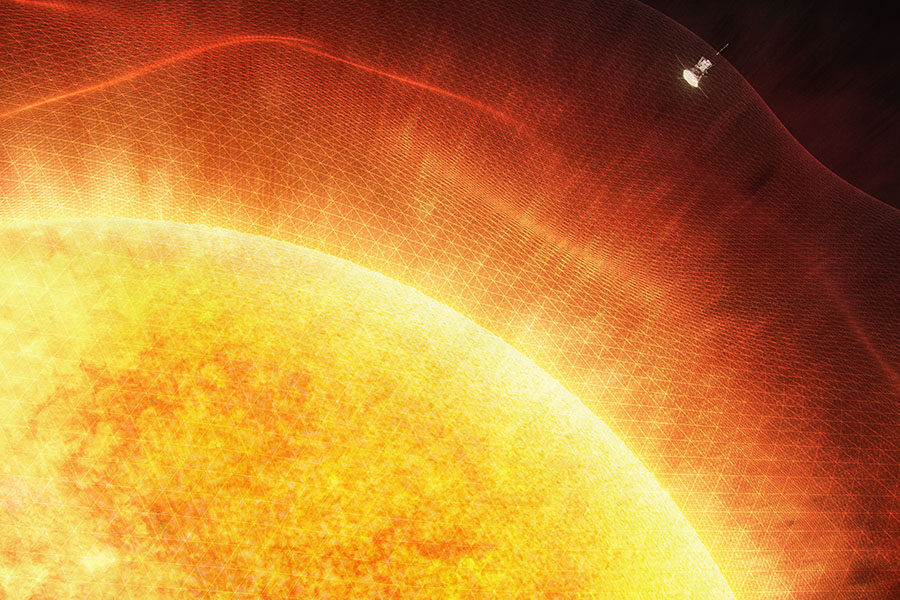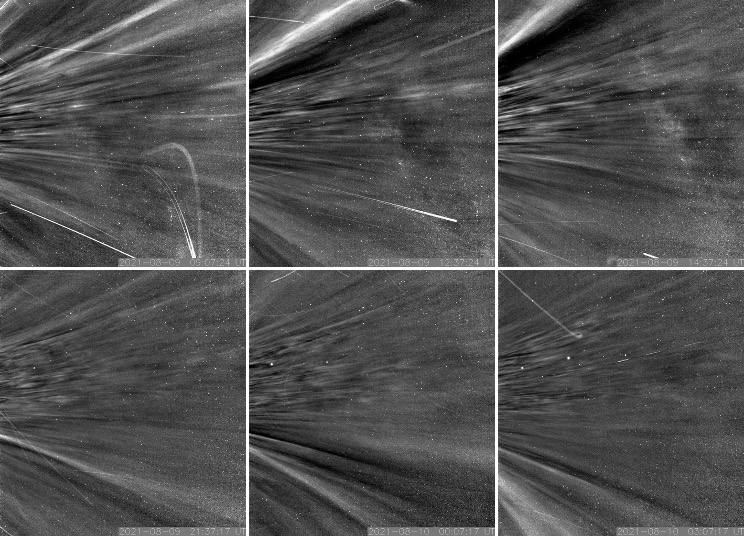On its eighth close pass, NASA’s record-breaking Parker Solar Probe entered our star’s atmosphere and “touched” the surface of the Sun.

NASA / Johns Hopkins APL / Ben Smith
Unlike Earth, the Sun doesn’t have a solid surface. But it does have a region of space around it where it governs its crackling plasma; beyond that, it cedes control. On April 28, 2021, NASA’s Parker Solar Probe slipped past that boundary, touching plasma and magnetic waves that are attached to the Sun.
That boundary is known as the Alfvén surface. Inside, the Sun’s magnetic field has a tight hold on the plasma, governing its movements. The magnetic field outside this surface is weaker, and plasma takes charge, dragging magnetic field lines with it as it streams outward in the form of the solar wind.
The probe actually entered the magnetized atmosphere a total of three times during its eighth pass around the Sun, explains Justin Kasper (University of Michigan, BWX Technologies, Inc.), primary investigator of the particle–detecting SWEAP instruments aboard the spacecraft. Kasper led a study on the crossings, published December 14th in Physical Review Letters, and announced the results with other team members at the ongoing meeting of the American Geophysical Union.
Read more about the Parker Solar Probe mission in the November 2020 issue of Sky & Telescope, and subscribe to support more stories like this one.
How to Touch the Sun
The first time Parker passed the Alfvén surface was the longest; it flew through the atmosphere for about five hours. Even as it continued flying toward the Sun, though, it popped back out, only to submerge again more deeply when it was at its closest approach — but briefly, that time exiting after just half an hour. Then, on its way outward, the spacecraft once again skimmed beneath the surface for more than an hour.
“[The Alfvén surface] has to be wrinkly,” Kasper says. “It’s not fuzzy — it’s well-defined while we’re under it — but the surface has some structure to it.” So while the probe sees a smooth change in conditions while crossing the boundary, where the boundary is can change. The reason for this wrinkly surface is still an open question, though the researchers suspect the crossing over a pseudostreamer lower in the corona pushed the boundary out to enable the first crossing.
What’s clear is that inside the Sun’s atmosphere, conditions are different than just outside. Parker saw plasma waves moving back and forth instead of flowing outward. That difference was visible not just to the SWEAP and FIELDS instruments, which measure particles and electric and magnetic fields, respectively, but also to the probe’s WISPR imager.

NASA / Johns Hopkins APL / Naval Research Laboratory
WISPR revealed structures in the solar wind that scientists had never seen from their previous vantage points. And not only did it image the structures, but it actually flew through them. “Imagine you’re riding on the Parker Solar Probe,” says Nour Raouafi (Johns Hopkins Applied Physics Laboratory). “When you see structures from afar, they look like they’re in the same location in space. But if you’re traveling through them, some would appear to fly above your head, while others pass below your feet.”
“We were flying through the source of the solar wind,” Raouafi says.
NASA / Johns Hopkins APL / Naval Research Laboratory
The view inside the corona may shed light on the Parker Solar Probe’s two main science objectives: the origin of the solar wind and the heat source for the million-degree corona. Analysis to address those objectives is ongoing and will soon include Parker’s ninth and tenth passes. Preliminary analysis indicates that the ninth pass, too, took Parker inside the Alfvén surface; data still hasn’t been downlinked from the 10th pass, which occurred on November 21st.
Sussing Out Switchbacks
From the probe’s insider view, scientists may also find an explanation for switchbacks, “S”-shape curves in the magnetic field. Though known to exist since the 1990s, Parker renewed interest in these structures because they were so ubiquitous in the solar wind.
“Are they forged on the surface of the Sun? Or are they shaped by some process that kinks the field on the way out from the Sun?” wonders Stuart Bale (University of California, Berkeley), principal investigator of the FIELDS instrument suite.
While the answers to those questions aren’t known just yet, the new observations show that the switchbacks occur in discrete patches, and they tend to have a higher percentage of helium ions. That connects them to the photosphere, the highest level of the Sun where most of the photons we see come from.
“It gets more interesting,” Bale says. He notes that the patches of switchbacks and their helium ions seem to be associated with magnetic funnels, regions between the giant convection cells in the Sun’s boiling plasma. While it’s still too soon to rule out any scenarios for switchbacks’ origins, he adds, “We’ll get there!”
NASA GSFC / CIL / Jonathan North
NASA Goddard / CIL / Jonathan North
The Parker Solar Probe will continue its spiral in toward the Sun, with its next closest approach in February. As it comes nearer, solar activity is also ramping up, promising additional insights in the future. “Humanity has ‘touched’ the Sun,” says program scientist Kelly Korreck (NASA HQ), “and revolutionary discoveries have just begun.”
 6
6









Comments
Rod
December 16, 2021 at 11:28 am
Monica Young, very nice report. I touched the Sun this morning viewing it with my telescope 🙂 However, the views are not as impressive as this report 🙂 [Observed 0945-1030 EST/1445-1530 UT. These six sunspot active regions were easy viewing this morning using the Orion Sirius 25-mm plossl, glass white light solar filter, Celestron #12 yellow filter, and 90-mm refractor at 40x views. The string of sunspots AR2909, AR2908, and AR2907 is some 350,000 km long, ~ 8.17 arcminute angular size on the Sun based upon spaceweather.com email alert received on 15-Dec-2021. "SUDDENLY, LOTS OF SUNSPOTS: The sun is experiencing a surge of sunspot formation. In the past 24 hours, a train of dark cores stretching more than 350,000 km has emerged in the sun's southern hemisphere. The new spots are growing rapidly and crackling with C-class solar flares. Watch the movie @ Spaceweather.com." Perhaps the end is near 🙂 My telescope true FOV ~ 75 arcminute in the eyepiece. The Sun’s angular size ~ 32.50 arcminutes. The Sun today is about one arcminute angular size larger in the sky then during the June, summer solstice this year. Earth is getting closer to aphelion distance now as we approach the winter solstice, 21-Dec-2021. At 40x, the telescope view resolved ~ 7.5 arcsecond or 5352 km diameter size on the Sun. Earth size ~ 18 arcsecond on the Sun.]
You must be logged in to post a comment.
Edward
December 17, 2021 at 6:53 pm
I believe you mean the earth is approaching perihelion.
You must be logged in to post a comment.
Rod
December 17, 2021 at 9:12 pm
Edward, good catch, yes. Perihelion in early January, aphelion in early July.
You must be logged in to post a comment.
maomarin
December 16, 2021 at 3:01 pm
increible he visto las manchas hoy desde el tropico colombiano,gracias universo y gracias "Rod" con su comentario corri a armar mi pequeño refractor...yujjuuu!!
You must be logged in to post a comment.
Rod
December 16, 2021 at 7:12 pm
de nada maomarin. Como esta amigo? Rodrigo esta aqui. Poquito espanol for me:)
You must be logged in to post a comment.
New Jersey Eclipse Fan
December 20, 2021 at 1:13 pm
Lectores--como ustedes--no saben que me retiré como profesor de español en 2020--¡es la verdad! No soy hablante nativo, pero la español fue mi materia favorita cuando era estudiante en mi juventud. [Translation: Readers--like you--don't know that I retired as a Spanish teacher in 2020--it's the truth! I'm not a native speaker, but Spanish was my favorite subject when I was a student in my youth.]
You must be logged in to post a comment.
You must be logged in to post a comment.